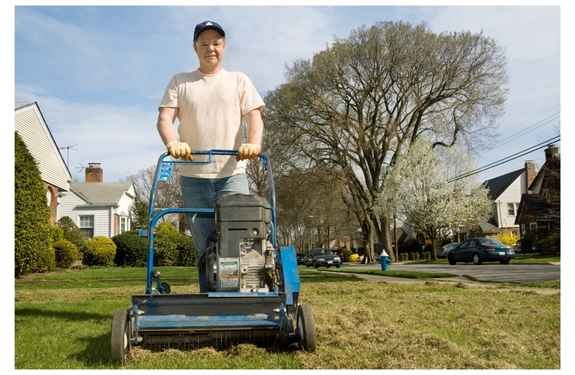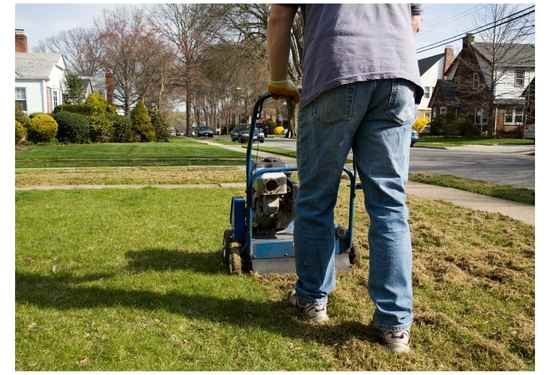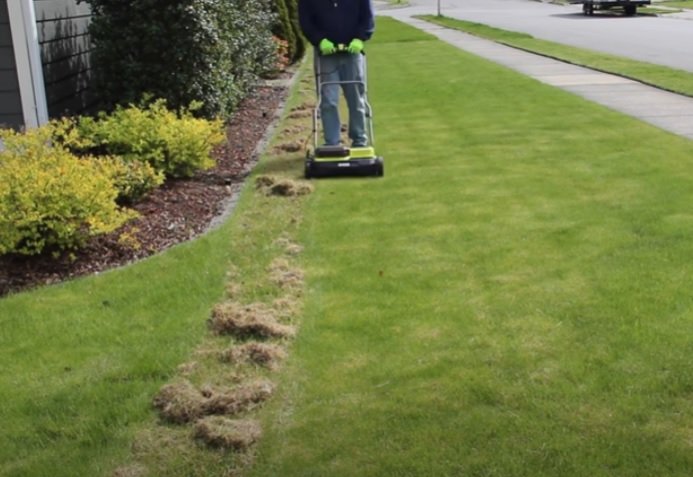We're an affiliate
We hope you love the products we recommend! Just so you know, we may collect a share of sales or other compensation from the links on this page. Thank you if you use our links, we really appreciate it!
Is it really necessary to power rake your lawn every year? If you’re like most people, you probably don’t have the time (or money) to do this annually.
So, what are the benefits of power raking? And how often should you do it?
What is Power Raking?
Power raking is the process of removing thatch from a lawn. Thatch is a layer of dead grass, leaves, and other organic matter that accumulates on the surface of the soil. This layer of debris can prevent water and nutrients from reaching the roots of the grass, which can lead to unhealthy turf. Power raking involves using a machine to remove this thatch layer and improve the health of your lawn.

While power raking may seem like a daunting task, it’s actually fairly simple. First, you’ll need to determine the thatch level of your lawn. To do this, remove a plug from your lawn. You can do this with a small shovel or a plug remover. Dig down about 4 to 6 inches. Looking at the plug, you should see good soil at the bottom. Now, determine where the soil changes into a different texture. This will be spongy and you can see grass clippings and other debris. That is the thatch layer. Measure thatch layer. If it is greater than ½ inch you, you have too much thatch.
Once you’ve determined the thatch level of your lawn, you can begin power raking. Start by mowing your lawn to a height of 2 inches and removing any obstacles, such as rocks or stones. Next, wet the ground to provide moisture for the machine and prongs. Then, start the machine and slowly move it over the surface of the lawn in forward and backward motions. Be sure to overlap each pass so that you evenly remove the thatch layer. Finally, rake up any debris and dispose of it properly.
Power raking is an important part of maintaining a healthy lawn. By regularly removing thatch, you can improve drainage and prevent problems with pests and diseases.
What is a Power Rake?
A power rake is a machine that is used to remove thatch from a lawn. They can be a machine with power raking as its only function. You can also buy a power rake blade, also called a dethatching blade, and put it on your walk-behind-mower.

Many rental companies will rent power raking machines for a very reasonable price. Another option is to hire a company to do the work for you.
GreenWorks makes a very affordable electric dethatcher that you can purchase for less than $150.
All these options beat doing the work manually.
Why should I worry about thatch?
Thatch is a layer of dead grass, roots, and other organic matter that accumulates on your lawn over time. If you have a lot of thatch, it can prevent water, fertilizer, and pesticides from getting to the roots of your grass. This can lead to unhealthy turf and even bare patches.
While thatch is a natural part of any lawn, too much of it can be a problem. You should remove thatch when it exceeds ½ inch in thickness.
There are several benefits to removing thatch from your lawn. First, it will improve the appearance of your turf. Second, it will increase the amount of water and nutrients that reach the roots of your grass. Finally, it will help control pests and diseases. If you have a lot of thatch on your lawn, don’t wait to remove it. Doing so will help keep your turf healthy and looking its best.
Is Power Raking Good for Your Lawn?
Power raking helps to remove thatch, which is a layer of dead grass and leaves that can prevent new growth. It can also loosen up compacted soil, making it easier for your lawn to breathe. If you have a lot of moss in your lawn, power raking can also help to get rid of it.
There are some downsides to power raking, however. If you power rake too often, you can damage the roots of your grass. And if you don’t do it properly, you can end up with bald spots on your lawn. So if you’re going to power rake, be sure to do it carefully and not too frequently.
What is the best time of year to power rake?
Late fall to winter is the best time to power rake. The growing season is over and there is no worry about damaging the turf. Power raking in the late spring can damage new growth. Power raking also loosens up the top layer of soil, making it easier for weeds to take root.
You can power rake in the spring, but it is not recommended. Spring is the time when new growth begins, so power raking can damage delicate fresh shoots.

Summer is too hot for power raking. If the average daily temperature is above 85 degrees, avoid power raking.
In the wintertime, frozen ground can damage equipment.
Are power raking and aerating the same thing?
There is a lot of confusion surrounding power raking and aerating. Some people think they are the same thing, but they are actually two different lawn care treatments. Power raking is a process of using a machine to remove thatch from your lawn. Aerating, on the other hand, involves poking small holes in your lawn to allow air and water to reach the roots of your grass.
So, what’s the difference between power raking and aerating?
Power raking is best done in the autumn, so your lawn will have time to recover. This treatment helps remove all the dead growth from summer so that your grass can thrive.
You should do aerating in early spring because it helps prepare your lawn for the growing season. By poking small holes in the ground, aerating allows water and air to reach the roots of your grass. It also helps reduce the soil compaction, allowing the soil to promote new growth.
Should I power rake or aerate?
So, which is more important for lawn health – power raking or aerating? The answer may depend on the condition of your lawn. If you have a lot of thatch built up, power raking may be the best way to improve drainage and allow your lawn to better absorb nutrients. If your lawn is compacted, aerating may be a better option to allow air and water to reach the roots of your grass.
Some people will do both. The power rake in the late fall and aerate in the spring.
When Should You Not Power Rake?
Many people believe that power raking is an effective way to remove debris from their lawns. However, there are certain conditions when you should not use a power rake. If the ground is too soft, power raking can damage the roots of the grass. You shouldn’t power rake during the growing season because the power rake could possibly damage your lawn.
Conclusion
Overall, power raking is a great way to remove thatch and improve the health of your lawn. It’s important to do it at the right time of year, and every 1-3 years should be sufficient. If you have questions about power raking, be sure to consult with a lawn care professional.

